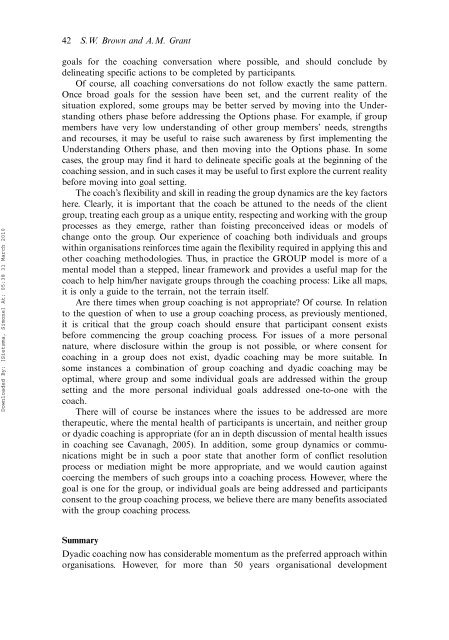42 S.W. Brown <strong>and</strong> A.M. GrantDownloaded By: [Sietsma, Simone] At: 05:38 31 March 2010goals for the coaching conversation where possible, <strong>and</strong> should conclude bydelineating specific actions to be completed by participants.Of course, all coaching conversations do not follow exactly the same pattern.Once broad goals for the session have been set, <strong>and</strong> the current reality <strong>of</strong> thesituation explored, some groups may be better served by moving into the Underst<strong>and</strong>ingothers phase before addressing the Options phase. For example, if groupmembers have very low underst<strong>and</strong>ing <strong>of</strong> other group members’ needs, strengths<strong>and</strong> recourses, it may be useful to raise such awareness by first implementing theUnderst<strong>and</strong>ing Others phase, <strong>and</strong> then moving into the Options phase. In somecases, the group may find it hard to delineate specific goals at the beginning <strong>of</strong> thecoaching session, <strong>and</strong> in such cases it may be useful to first explore the current realitybefore moving into goal setting.The coach’s flexibility <strong>and</strong> skill in reading the group dynamics are the key factorshere. Clearly, it is important that the coach be attuned to the needs <strong>of</strong> the clientgroup, treating each group as a unique entity, respecting <strong>and</strong> working with the groupprocesses as they emerge, rather than foisting preconceived ideas or models <strong>of</strong>change onto the group. Our experience <strong>of</strong> coaching both individuals <strong>and</strong> groupswithin organisations reinforces time again the flexibility required in applying this <strong>and</strong>other coaching methodologies. Thus, in practice the GROUP model is more <strong>of</strong> amental model than a stepped, linear framework <strong>and</strong> provides a useful map for thecoach to help him/her navigate groups through the coaching process: Like all maps,it is only a guide to the terrain, not the terrain itself.Are there times when group coaching is not appropriate? Of course. In relationto the question <strong>of</strong> when to use a group coaching process, as previously mentioned,it is critical that the group coach should ensure that participant consent existsbefore commencing the group coaching process. For issues <strong>of</strong> a more personalnature, where disclosure within the group is not possible, or where consent forcoaching in a group does not exist, dyadic coaching may be more suitable. Insome instances a combination <strong>of</strong> group coaching <strong>and</strong> dyadic coaching may beoptimal, where group <strong>and</strong> some individual goals are addressed within the groupsetting <strong>and</strong> the more personal individual goals addressed one-to-one with thecoach.There will <strong>of</strong> course be instances where the issues to be addressed are moretherapeutic, where the mental health <strong>of</strong> participants is uncertain, <strong>and</strong> neither groupor dyadic coaching is appropriate (for an in depth discussion <strong>of</strong> mental health issuesin coaching see Cavanagh, 2005). In addition, some group dynamics or communicationsmight be in such a poor state that another form <strong>of</strong> conflict resolutionprocess or mediation might be more appropriate, <strong>and</strong> we would caution againstcoercing the members <strong>of</strong> such groups into a coaching process. However, where thegoal is one for the group, or individual goals are being addressed <strong>and</strong> participantsconsent to the group coaching process, we believe there are many benefits associatedwith the group coaching process.SummaryDyadic coaching now has considerable momentum as the preferred approach withinorganisations. However, for more than 50 years organisational development
<strong>Coaching</strong>: <strong>An</strong> <strong>International</strong> <strong>Journal</strong> <strong>of</strong> <strong>Theory</strong>, <strong>Research</strong> <strong>and</strong> Practice 43practitioners have primarily focused interventions at the group level. Therefore, theemergence <strong>of</strong> group coaching seems a logical integration <strong>of</strong> these changemethodologies. We have presented an overview <strong>of</strong> group coaching <strong>and</strong> have arguedthat it can be an important means <strong>of</strong> goal-focused change in organisational settings.In addition, we have outlined a model <strong>of</strong> GROUP coaching that integrates thedyadic GROW model with Scharma’s U Process <strong>and</strong> other established groupmethodologies. We believe that this approach to group coaching provides an effectiveway <strong>of</strong> harnessing the goal-focused nature <strong>of</strong> dyadic coaching with the dynamicenergy <strong>and</strong> systemic perspectives inherent in group processes, thus positioningsystemic factors at the core <strong>of</strong> the coaching process. In this way, <strong>and</strong> throughdeveloping systems thinking in their clients, executive coaches <strong>and</strong> consultants maybetter foster real change at the individual, group <strong>and</strong> organisational level.Downloaded By: [Sietsma, Simone] At: 05:38 31 March 2010References<strong>An</strong>derson, M.C., <strong>An</strong>derson, D.L., & Mayo, W.D. (2008). Team coaching helps a leadershipteam drive cultural change at caterpillar. Global Business <strong>and</strong> Organisational Excellence,May/June, 4050.Argyris, C. (1991). Teaching Smart People How to Learn. Reflections, 4(2), 415.Ascentia. (2005). Leicester Case Study Feedback Group <strong>Coaching</strong> - Can it make a difference?<strong>International</strong> <strong>Journal</strong> <strong>of</strong> Evidence Based <strong>Coaching</strong> <strong>and</strong> Mentoring, 3(1).Bloisi, W., Cook, C., W., & Hunsaker, P.L. (2003). Management <strong>and</strong> organisational Behaviour.Berkshire: McGraw-Hill Education.Brown, D., & Harvey, D. (2006). <strong>An</strong> Experiential Approach to Organisation Development(Seventh ed). New Jersey: Pearson Education.Cavanagh, M. (2005). Mental-health issues <strong>and</strong> challenging clients in executive coaching.In M. Cavanagh, A.M. Grant & T. Kemp (Eds.), Evidence-based coaching (vol 1):Contributions from the behavioural sciences (pp. 2136). Qld: Australian Academic Press.Christensen, K. (2008). Thought Leader Interview: Chris Argyris. Rotman Magazine (Winter),1013.Clutterbuck, D. (2007). <strong>Coaching</strong> the Team at Work. London: Nicholas Brealey.Diedrich, R.C. (2001). Lessons Learned in-<strong>and</strong> Guidelines for-<strong>Coaching</strong> Executive Teams.Consulting Psychology <strong>Journal</strong>: Practice & <strong>Research</strong>, 53(4), 238239.Goldsmith, M., & Morgan, H. (2000). Team Building Without Time Wasting. In M.Goldsmith, L. Lyons & A. Freas (Eds.), <strong>Coaching</strong> For Leadership (pp. 103109). SanFrancisco: Jossey-Bass/Pfeiffer.Grant, A.M. (2007). A model <strong>of</strong> goal striving <strong>and</strong> mental health for coaching populations.<strong>International</strong> <strong>Coaching</strong> Psychology Review, 2(3), 248262.Greene, J., & Grant, A.M. (2003). Solution-focused coaching: Managing people in a complexworld. London: Momentum Press.Hackman, J.R., & Wageman, R. (2005). A <strong>Theory</strong> <strong>of</strong> Team <strong>Coaching</strong>. Academy <strong>of</strong>Management Review, 30(2), 269287.Hamlin, R.G., Ellinger, A.D., & Beattie, R.S. (2009). Toward a Pr<strong>of</strong>ession <strong>of</strong> <strong>Coaching</strong>?A Definitional Examination <strong>of</strong> ‘<strong>Coaching</strong>,’ Organisation Development,’ <strong>and</strong> ‘HumanResource Development’. <strong>International</strong> <strong>Journal</strong> <strong>of</strong> Evidence Based <strong>Coaching</strong> <strong>and</strong> Mentoring,7(1), 1338.Hargrove, R. (2003). Masterful <strong>Coaching</strong>. San Francisco: Jossey-Bass/Pfeiffer.Hawkins, P. (1991). The Spiritual Dimension <strong>of</strong> the Learning Organisation. ManagementEducation <strong>and</strong> Development <strong>Journal</strong>, 22(3), 17287.Hunter, D., Bailey, A., & Taylor, B. (1996). The Facilitation <strong>of</strong> Groups. Hampshire: Gower.<strong>International</strong> Coach Federation (2007). <strong>International</strong> Coach Federation: Global coachingsurvey. Lexington, KY, <strong>International</strong> Coach Federation.Isaacs, W. (1999). Dialogue <strong>and</strong> the Art <strong>of</strong> Thinking Together. New York: Double day.
















